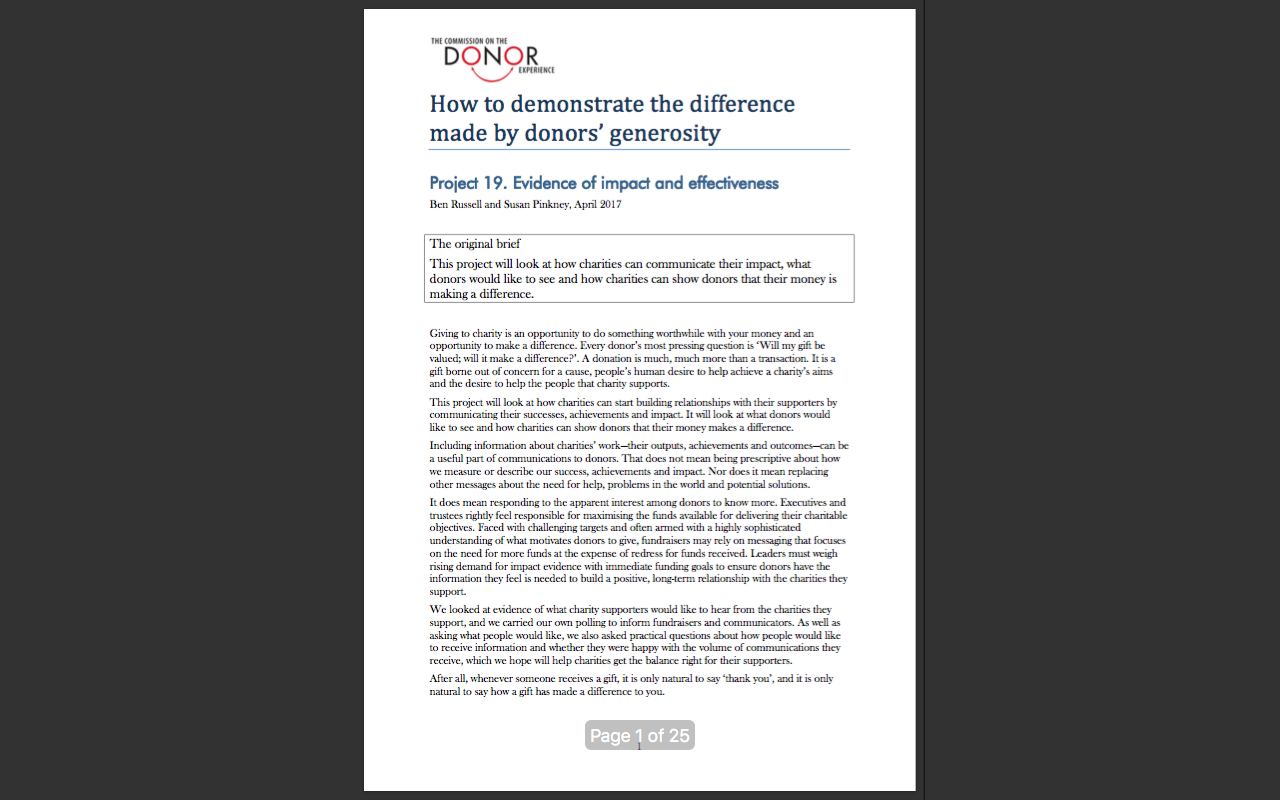CDE project 19 section 3: putting the principles into action and practice
- Written by
- The Commission on the Donor Experience
- Added
- April 29, 2017
Putting the principles and actions into practice
Include some content about your achievements in follow-up messages to donors:
There is no one-size-fits-all approach here. Just as there are many different ways of articulating success, achievements and impact (and many specialists in this area), so there are many types and sizes of charity for whom different measures will be useful (and practical). However, in both focus groups and subsequent polling, we found people’s stated desire to know more about what charities achieve is strong.
Respondents were shown a list of types of information they could receive from charities and asked to select up to five types of information they would like to receive. The main types selected were the ones that demonstrate impact in some way.
When receiving information from charities, what specific things would you most like to hear about? Please select up to 5 options. Base: 640 (all those who donate to charity).
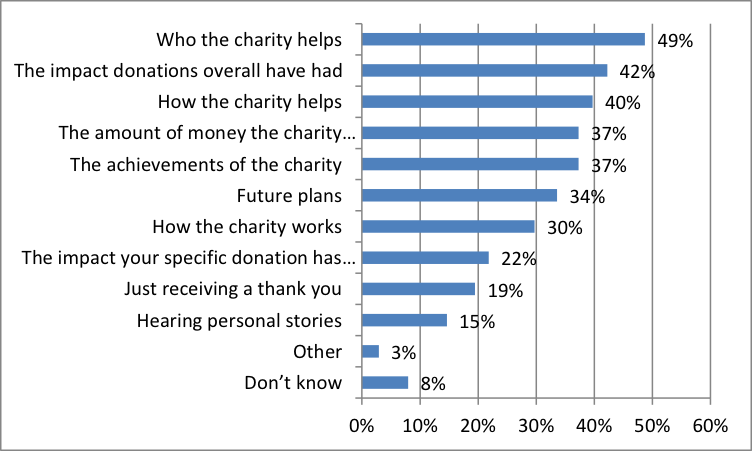
‘Who the charity helps’ comes out on top of the things people would like to hear (49%), followed by ‘the impact donations overall have had’ (42%) and ‘how the charity helps’ (40%). Although only just over a fifth (22%) would like to hear about the ‘impact your specific donation has…’, we see some differences amongst the younger age group on this, with 40% of 16–24 year olds wanting to hear about this. Interestingly, 16–24 year olds are also more likely to say they would like to receive a ‘thank you’ from the charities they support (38%), despite only 19% overall saying this.
This question is difficult to unpick, but broadly chimes with our qualitative findings, which showed that people want tangible examples: they want to see outcomes rather detail and they are more interested in evidence of achievement than organisational information. We were surprised that the idea of hearing personal stories was not ranked more highly, but suspect that reflects people’s desire to see some concrete evidence of progress.
This chimes with NPC’s work in their Money for Good UK report, which found that how an organisation will use a donation and evidence that an organisation has an impact were ranked as the top factors influencing donations among mainstream donors, with 63% of donors paying close or extremely close attention.
However, there is a tension between this desire to know more and worry that a donation will simply lead to many requests for more money—something that donors identify as a real barrier to giving. Previous market research conducted in 2012 found that many people feel that the fear of being inundated with requests for more money is a barrier to giving. Therefore, communications could be more about success than simply asking for a transaction.
Similar findings emerge from recent survey work by nfpSynergy. When asked what are the main factors that would influence you to give to charity, the most popular answer was ‘the charity is clear about what the donations are spent on’ (56%) followed by 'learning about the impact the charity has’ (47%). [1]
In our survey, respondents were asked directly on impact. The chart below shows how likely they would be to look at data on the impact of the charities they support on their website.
If data was available on the impact of the charities you support and was accessible via their website, how likely would you be to look at it? Base: 640 (all those who donate to charity).
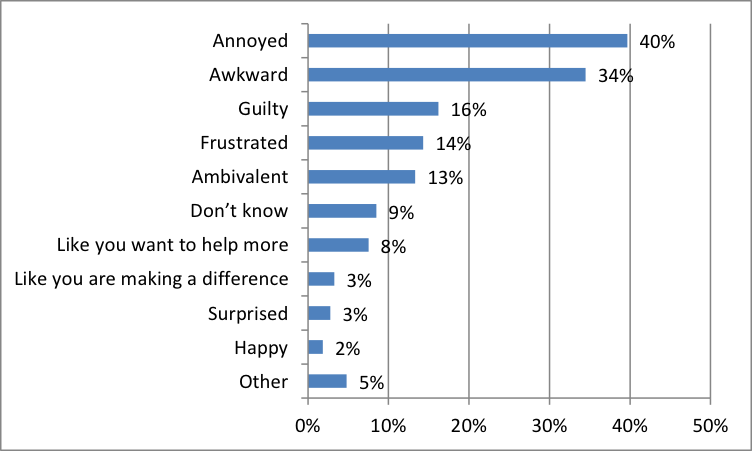
Overwhelmingly, negative descriptors are endorsed on how respondents feel when asked for money by a charity. Two words score much higher than any other: annoyed (40%) and awkward (34%). There is then quite a drop to the next highest word: guilty (16%) and frustrated (14%). The highest level for a positive word or phrase was ‘Like you want to help more’, but this was chosen by fewer than one in ten (8%).
This may be unsurprising, given the volume of negative media coverage about fundraising over the past year. It may also be a reaction to the phrasing of the question, namely, asking how people feel when they are asked for more money. Culturally, British people tend not to like talking about money, or their giving, so that may feed the stated annoyance at fundraising asks. However, the contrast between this finding and the positive sentiment around charities’ impact suggests there is a case for shifting the emphasis to achievements and progress in fundraising communications.
Easily understood, compelling and if possible human stories of how
charities help are most likely to cut through
In many ways, this is a watchword of communicators. As Mother Theresa said, ‘If I look at the mass I will never act. If I look at the one, I will.’ [1] However, there is a strong argument for balance: a human story should accompany statistics about impact and figures should accompany a human story.
That neatly sums up the balance between providing human-scale examples and potentially dry figures.
Psychological data seems to support this: the more specific and human an example, the more it resonates. Telling donors how the charity’s work has improved the life of one girl will be more effective than telling them how the charity’s work has improved the life of a whole village. Similarly, a study by Tehila Kogut and Ilana Ritov suggests that people are more likely to help individuals if they are perceived to be close to their own ‘in-group’, suggesting that individual stories of impact will resonate if donors can clearly relate to them. [2]
A good example of this approach is SolarAid, which took surveys of beneficiaries and an analysis of the overall cost to the organisation of providing each solar light to produce a highly compelling calculator linking donations and outputs—the number of lights provided—to human outcomes. The calculator allowed donors to see, for example, how many hours of extra study or homework a light allowed, turning a donation into a tangible item of use to people and giving an everyday human-scale example of how that helped. This information was shareable, allowing donors to become advocates for the organisation on social media.
The voice of service users can be really helpful here. Recent work by NPC outlines how charities can incorporate the voice of their users in planning, service improvement and evaluation. [3] There is a clear opportunity to use service feedback and users’ stories to help articulate both the outputs of charitable work and its impact.
Another good example is Cancer Research UK online, which very clearly outlines the wealth of research projects the organisation is funding, broken down by type of cancer and type of research. Web pages give examples of people involved in trials and case studies of the medical practitioners leading the work. This is not labelled as impact measurement as such, but gives a clear view of the types of work the organisation is doing.
Certainly, the clear anecdotal view of charities that helped with case studies was that donors appreciated an element of feedback and liked a clear personal story. For example, the Catholic Agency for Overseas Development (CAFOD) had high levels of feedback when it included personal stories of volunteers working on the front line of the refugee crisis in its regular magazine to supporters.
You also can see this in major campaigns. After the ice bucket challenge phenomena, motor neurone disease charities successfully provided clear feedback on what the money raised was spent on. That clearly yielded some very positive media coverage, which helped convey the message that the charities involved had taken action as a result of an unexpected fundraising event. [4]
The Marie Curie impact report also gives a great combination of images, human stories and statistics to back them up. So for example, quotes from their nurses about their work are juxtaposed with survey ratings, saying that 93% of people rated their nursing and hospice services as very good—the highest possible ratings. The report also quotes the families of people who benefitted from the charity’s services, telling their stories, alongside statistics about the volume of their work.
[1] Slovic, P. (2007) ‘If I look at the mass I will never act’: Psychic numbing and genocide. Judgment and Decision Making. 2(2), 79–95.
[2] Kogut, T. & Ritov, I. (2007) ‘One of us’: Outstanding willingness to help save a single identified compatriot. Organizational Behavior and Human Decision Processes. 104(2), 150–157.
People say they prefer email, direct mail and newsletters communications
When asked, email is clearly the means of communication that people said they preferred, followed by direct mail and newsletters.
Another aim of this research was to find out how people believe charities currently communicate with them. The chart below shows the various means in which respondents think the charities they support currently communicate with them.
In which ways, if any, do the charities you support currently communicate with you? Please select all that apply. Base: 640 (all those who donate to charity).
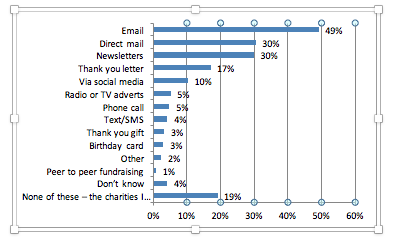
The main source of current communication cited was email, which around half (49%) receive communication via. This was followed by around a third mentioning each of direct mail (30%) and email (30%). With the exception of social media (10%), all of the communication channels mentioned by more than one in ten were direct contact methods. One in five (19%), a sizeable minority, also claimed the charities they support do not communicate with them, which may explain the levels of those saying they currently do not receive enough information on some of the aspects. It is, perhaps, surprising that nearly one in five said they did not get any communication from charities, although it is possible they simply did not recall having been contacted, say by direct mail or email.
Shown the same list, respondents were then asked how they would like the charities they support to communicate with them, and asked to pick up to five methods.
And how would you most like the charities you support to communicate with you? Please select up to 5 options. Base: 640 (all those who donate to charity.

By far, the most desired method of contact was email (57%), followed by newsletters (25%) and direct mail (18%). It is reassuring that these are also the top three ways in which respondents are currently communicated with. However, it would appear from the difference in the levels between the two questions that fundraisers may be underusing email and overusing direct mail in particular, in respondents’ eyes. Just under a fifth (18%) said they did not want communication.
Most people say they are satisfied with the level of communications they receive
We asked about the updates they received on the work of charities they support. The results are shown below.
In general, how much information do you currently receive from the charities you support once you have donated to them? On updates on their work. Base: 640 (all those who donate to charity).
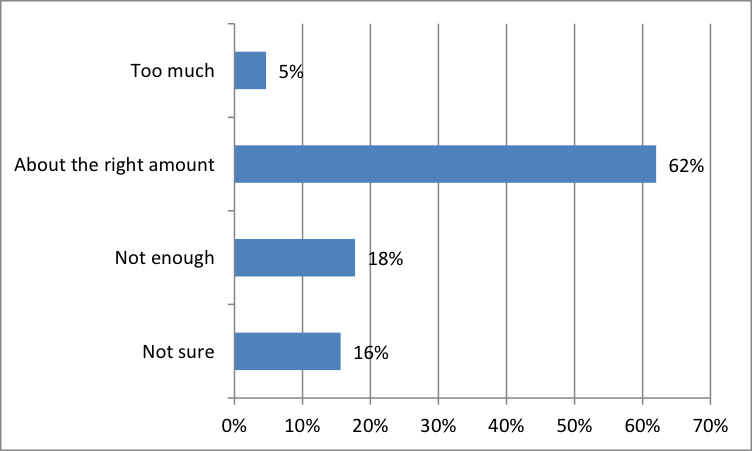
Donors are generally more happy with the amount of information updates they receive on the charities’ work, with 62% saying they receive about the right amount and 5% saying they receive too much. However, almost one in five (18%) believe they do not receive enough information on this aspect. There is a very similar pattern in terms of age, to that seen on how the charities spend the money they donate, with 28% of 16–24s saying they do not receive enough information.
Do donors feel they get enough information about new charity campaigns?
The final aspect asked in terms of information received relating to new campaigns.
In general, how much information do you currently receive from the charities you support once you have donated to them? On new campaigns. Base: 640 (all those who donate to charity).
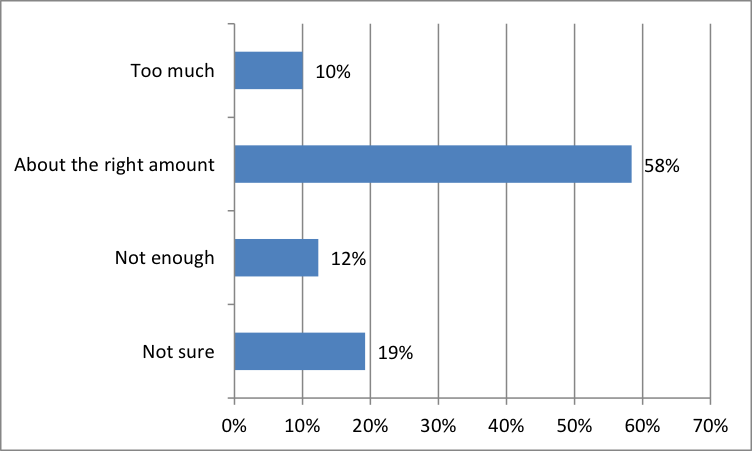
Of all four issues we asked about, donors were the most likely to believe they receive about the right amount of information about new campaigns, with one in 10 donors saying they received ‘too much’ information. This question also produced the lowest proportion of people saying they received ‘not enough’ information.
Of course, 58% of people thought the information they received was about right and a relatively small proportion wanted more. There may be issues with the term ‘campaigns’, which could raise associations with advertising or lobbying activity. Certainly, this would not suggest that more communications is required.
One of our aims was to get a broad sense of whether people wanted charities to get in touch with them. So respondents were asked, on a 5-point Likert scale, how much they agreed or disagreed that ‘I want charities I support to communicate with me from time to time.’
To what extent do you agree or disagree with the following statement? ‘I want charities I support to communicate with me from time to time.’ Base: 640 (all those who donate to charity).

Almost half (47%) agreed with the statement ‘I want charities I support to communicate with me from time to time’. However, there is not a huge amount of strength of opinion within this, with only 8% agreeing strongly and a third (34%) neither agreeing nor disagreeing. On the whole, though, with only 16% disagreeing with this statement, it would appear the majority do want to receive communications. Although not significantly higher, there is a higher percentage of 16–24 year olds agreeing with this statement. This further supports the figures seen on earlier questions, which suggests this age group in particular does want more information on certain aspects.



